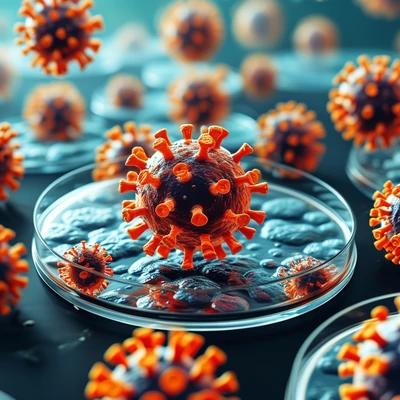Researchers from MIT and other institutions have discovered compounds that can fight viral infections by activating a defense mechanism within host cells. These findings suggest the potential for developing broad-spectrum antiviral drugs.
The team identified these compounds, which stimulate the integrated stress response pathway in cells, after screening nearly 400,000 molecules. Tests on human cells revealed that these compounds effectively countered infections from RSV, herpes virus, and Zika virus. They also showed promise against herpes infection in mouse trials.
The researchers now intend to test these compounds against more viruses with the hope of eventually moving them into clinical trials.
"We're enthusiastic about this research because it allows us to leverage the host cells' stress response to create a method for identifying and developing broad-spectrum antivirals," says James Collins, Termeer Professor of Medical Engineering and Science at MIT's Institute for Medical Engineering and Science (IMES) and Department of Biological Engineering.
Collins and Maxwell Wilson, an associate professor of molecular biology at the University of California, Santa Barbara, and chief scientific officer of Integrated Biosciences, are the senior authors of the study, published in Cell. Felix Wong, a former MIT postdoc and CEO of Integrated Biosciences, is the lead author. The research team includes scientists from Illumina Ventures, Princeton University, UCSB, and Integrated Biosciences.
CellIn human cells, the integrated stress response pathway activates in reaction to viral infections along with other stressors like starvation. During a viral infection, this pathway is triggered by double-stranded RNA produced during viral replication. The cell halts protein synthesis, thereby blocking the virus's ability to replicate.
The researchers believe that compounds enhancing this pathway could be effective new antiviral drugs applicable against various viruses.
"Normally, antivirals are developed for specific viruses," Wong explains. "In our case, we thought modulation of the host cell stress response might lead to a new class of broad-spectrum antivirals—agents acting directly on host cells to alter fundamental aspects of viral replication."
To find compounds enhancing this pathway during infection, researchers developed an optogenetic screen that incorporates light-sensitive proteins engineered into the cell's genome. They modified a protein called PKR, which triggers the stress response, so it could be activated by light.
This technique allowed them to test a library of 400,000 compounds on human cells exposed to blue light, mimicking viral infection via PKR activation.
The survival rates of these cells helped identify which compounds boosted the pathway's activity and enhanced viral reproduction shutdown. Approximately 3,500 potential antiviral compounds were found and further evaluated.
"In essence, our compounds fully activate the pathway during viral infection," Wong notes. "Even low virus levels trigger a maximal antiviral response when the pathway is stimulated."
The researchers then selected eight promising compounds for screening to determine their ability to neutralize viruses while being safe for human cells. They narrowed it down to three leading candidates: IBX-200, IBX-202, and IBX-204.
In cell cultures infected with Zika virus, herpes virus, or RSV, these compounds significantly reduced viral amounts. They then tested compound IBX-200 in mice infected with herpes virus and found it reduced viral load and improved symptoms.
The experiments suggest that these compounds activate an enzyme detecting cellular stress, initiating the stress response pathway to make cells more resistant to infection. When applied to uninfected cells, the compounds have no effect.
Next, researchers plan to test their leading candidates against a wider variety of viruses and explore additional compounds that activate integrated stress responses or other cellular pathways to combat viral or bacterial infections.


